The Ticwatch Pro 3 is the new ultimate Wear OS smartwatch because it's fast, has all the best parts of Google and tracks many vital signs.
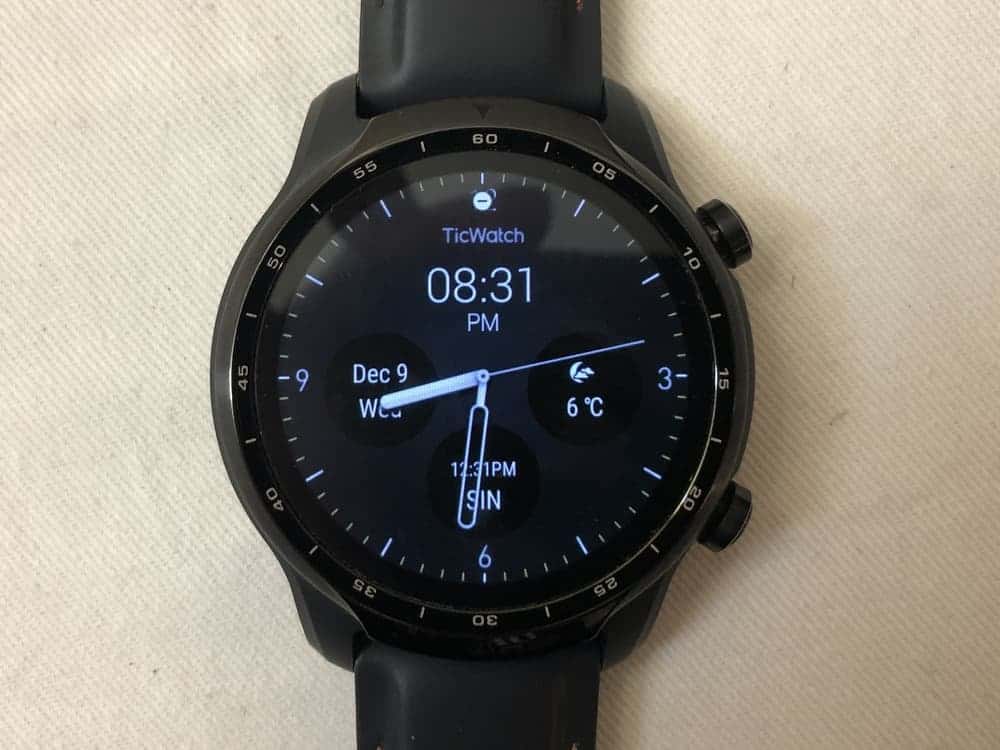
Features:
- Dual-layer screen that prolongs battery life
- Latest Qualcomm Snapdragon Wear 4100 processor
- Fast, lag-free performance
- Wear OS conveniences like Google Assistant and fantastic speech to text system
- Sleep tracking, SpO2, hearing tracking, stress monitoring
Mobvoi’s Ticwatch Pro 3 GPS is so much more “pro” as compared to its predecessor.
It looks much more elegant with its watch case that’s based on different shades black. A shiny bezel and a matte rim makes a great complement to the silicone black strap with orange threads running alongside the notches.
Contents
- Weight
- Return of the dual layer screen
- Essential Mode
- Battery Life
- The Ticwatch Pro 3 deserves the F-word
- Phone quality
- No crown
- Ticwatch-specific Software
- TicHealth
- TicExercise
- TicPulse
- TicSleep
- TicZen and TicBreathe
- TicOxygen
- TicHearing
- Productivity
- Texts and emails
- Google Assistant
- App store
- Verdict
- FAQs
- Ticwatch Pro 3 vs Apple Watch Series 6
- Ticwatch Pro 3 vs Fitbit Sense
- Ticwatch Pro 3 vs (original) Ticwatch Pro
- Ticwatch Pro 3 vs Fossil Gen 5 Carlyle
- Ticwatch Pro 3 vs Ticwatch C2/E2/S2
- Ticwatch Pro 3 vs Suunto 7
- Ticwatch Pro 3 vs Samsung Galaxy Watch3
- Ticwatch Pro 3 vs Garmin Fenix 6
- Ticwatch Pro 3 vs Polar Grit X
Upon flipping the Ticwatch Pro 3 GPS, you’ll notice a few similarities and a major difference.
The chief difference here is that the heart rate sensor is much more complex than all previous Ticwatches.
It now sports red and green LEDs surrounding a central light sensitive meter.
The classic four pin charging ports are still there but unlike the previous Ticwatches, the Mobvoi Ticwatch Pro 3 comes with a much smaller charging dock that doesn’t encompass the whole watch. Rather, it’s a oval-shaped dock goes directly to the side where the charging pins are, guided by magnets that repel it if it’s in the wrong direction.
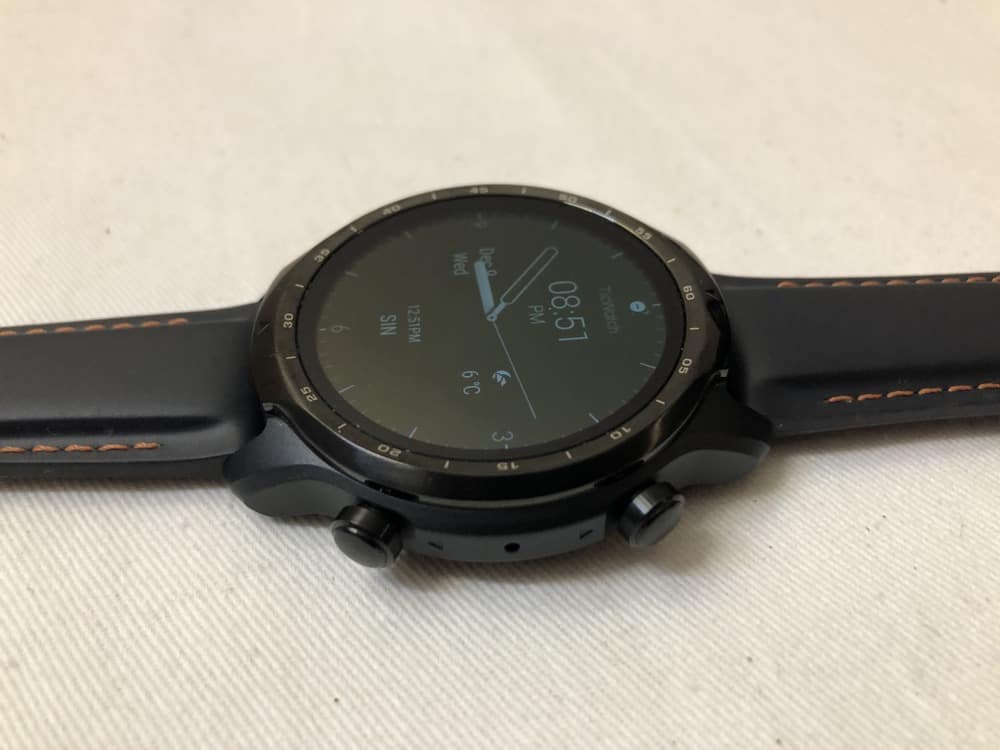
Weight
The Ticwatch Pro 3’s weight feels much more in line with the watches in its class such as the Apple Watch Series 6 (44mm version) and the Samsung Galaxy Watch3.
Mobvoi’s previous iteration was heavy. I don’t know what Mobvoi did to cut its weight down but it’s now a lighter watch and better watch. Amazing!
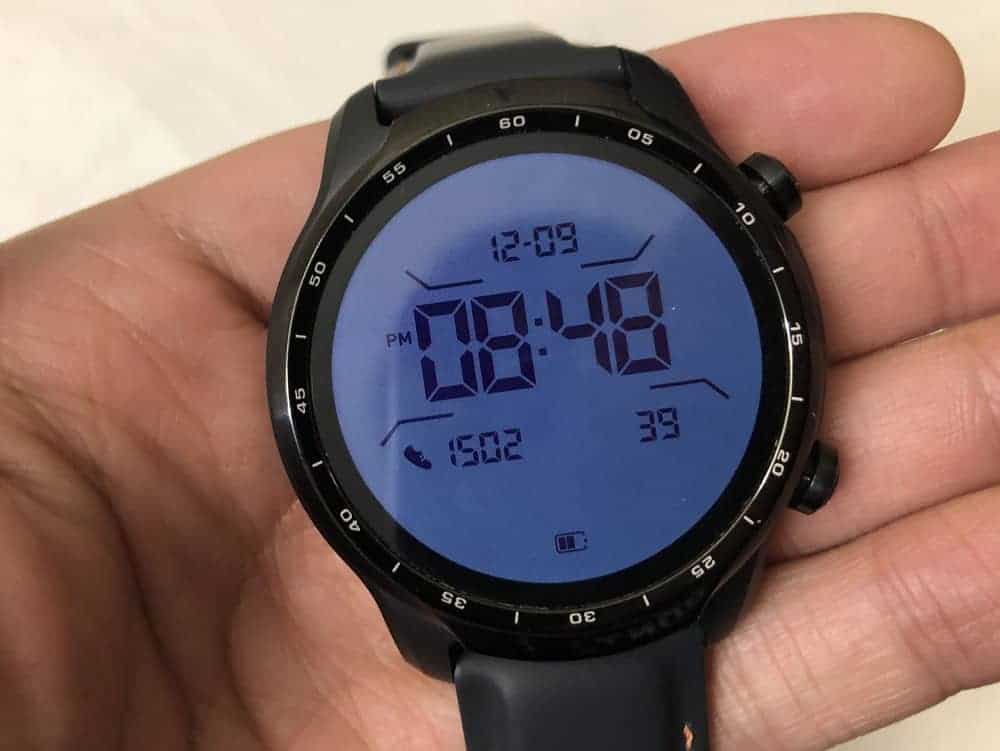
Return of the dual layer screen
The dual layer screen is a true Mobvoi innovation and I am glad it’s back.
It’s really good. If you are in extremely bright sunlight, you’ll really appreciate it because most smartwatches would need to turn up its backlight to the max, hence draining battery life much more severely. In addition, if you have the always on mode turned on, that smartwatch will constantly have a battery suck turned on.
Whereas with the dual layer screen, the LCD layer is always on. It’s really battery saving, especially because it uses ambient light to keep the screen visible.
What’s even better now is that Mobvoi has included a backlight that activates if it senses you’re tilting your wrist to look at the watch.
Previously, the older Mobvoi Ticwatch Pro would activate the LED screen.
This is a much improved way of doing things. I really like that the backlight is automatically activated too. Even on some high end smartwatches like the Garmin Fenix 6, both of which use LCD screens, they require you to press a button in order to activate the LCD’s backlight.
The dual layer screen offers more information than just time, steps, date and battery life.
Upon activating an exercise feature in TicExercise, I could see that the LCD screen started displaying time elapsed, heart rate and elevation changes. This is great, since I enjoy doing workouts in the sun and therefore it’ll be a real battery sapper if the smartwatch had to turn on the LCD screen.
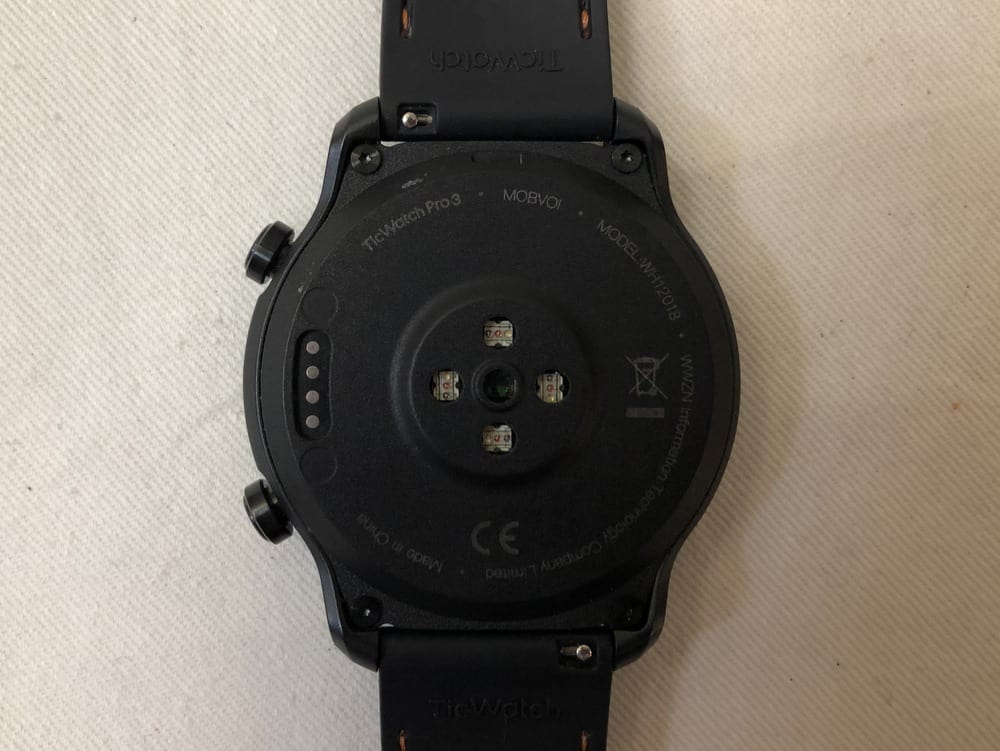
Essential Mode
Do you want up to 45 days of battery life?
That’s what Mobvoi claims the Ticwatch Pro 3 GPS can get in essential mode which is a battery sipping mode that tracks your steps and shows you the time, but otherwise disables the main LED screen and also the heart rate and blood oximeter’s LEDs.
Battery Life
The battery life of the Ticwatch Pro 3 GPS is actually very impressive due to its power saving screen.
This is one of the few Wear OS smartwatches that doesn’t require daily charging even if you are wearing it 24/7. You can charge it every other day while still having the always on screen activated.
The most advanced of Qualcomm’s Snapdragon processors, the Snapdragon Wear 4100, really sips battery power as compared to its predecessors. Qualcomm’s product brief explains that the Snapdragon Wear 4100 will deliver 85 per cent more performance as compared to the Qualcomm Snapdragon Wear 3100 but uses less power with the use of a co-processor and a new ultra-lower power platform.
One thing I’ve noticed is that sports no longer drains the battery down like an older Ticwatch would. The older Ticwatch Pro would be drained to about 30 per cent of battery life if you use its internal GPS and go for an exercise that lasts hours. That’s no longer the case.
The Ticwatch Pro 3 deserves the F-word
Fast.
The Ticwatch Pro 3 GPS comes with the new Snapdragon Wear 4100 processor and 1GB of RAM which means that it has better specifications than Fossil’s top of the line Gen 5 smartwatches.
It’s noticeable, especially when you use Google Assistant. Google Assistant sometimes suffers from lag if you have a slower processor or less RAM.
Usually, this means Google Assistant is unresponsive even though it’s asking you to speak. That’s a real frustration.
With the Ticwatch Pro 3 GPS, when it says “Speak now,” it really means you can start asking Google Assistant to do something.
Wear OS smartwatches have had a reputation of being slow, laggy and sluggish. Twelve months ago. Now, with software updates and better hardware, the Wear OS is no longer the same Wear OS that I remembered writing about back then.
The test always came when you had a software update running in the background and you wanted to do something with your smartwatch. All of Mobvoi’s more entry-level smartwatches would struggle, but the Ticwatch Pro 3 GPS didn’t. In fact, I didn’t even notice it was updating in the background because everything was so smooth.
Fantastic.

Phone quality
I love having the ability to make calls on my Ticwatch Pro 3 or any smartwatch for that matter.
Sometimes I don’t know where my phone is and a call comes in. Or sometimes I don’t want to hold my phone to my ear while I’m on the move.
The Ticwatch Pro 3 can make calls and also answer calls as if you were on your phone.
Microphone quality is good when tested in a quiet room. However, I found that the speaker’s quality wasn’t that good as I had trouble understanding the caller and I generally did not have any problems if I were to use my phone.
No crown
A crown is a knob on a watch that allows you to scroll through menus. In classic watches, they were used to set the time.
It’s hard to appreciate how useful having a crown (or rotating bezel as seen on Samsung Galaxy Watch smartwatches) is when you have to scroll long menus.
There are two instances where I wished I had a crown or rotating bezel. First, trying to find an app by swiping on the two-column Wear OS app menu can take a long time as the menu is quite long and it only gets longer since the Google Play Store has many apps that you can install on the Ticwatch Pro 3.
The other instance where I wished I had a crown was in the Google Fit Workout menu when I had to pick my workout from its long list. It was a pain to swipe through the list and only advancing five or so workouts at a time.
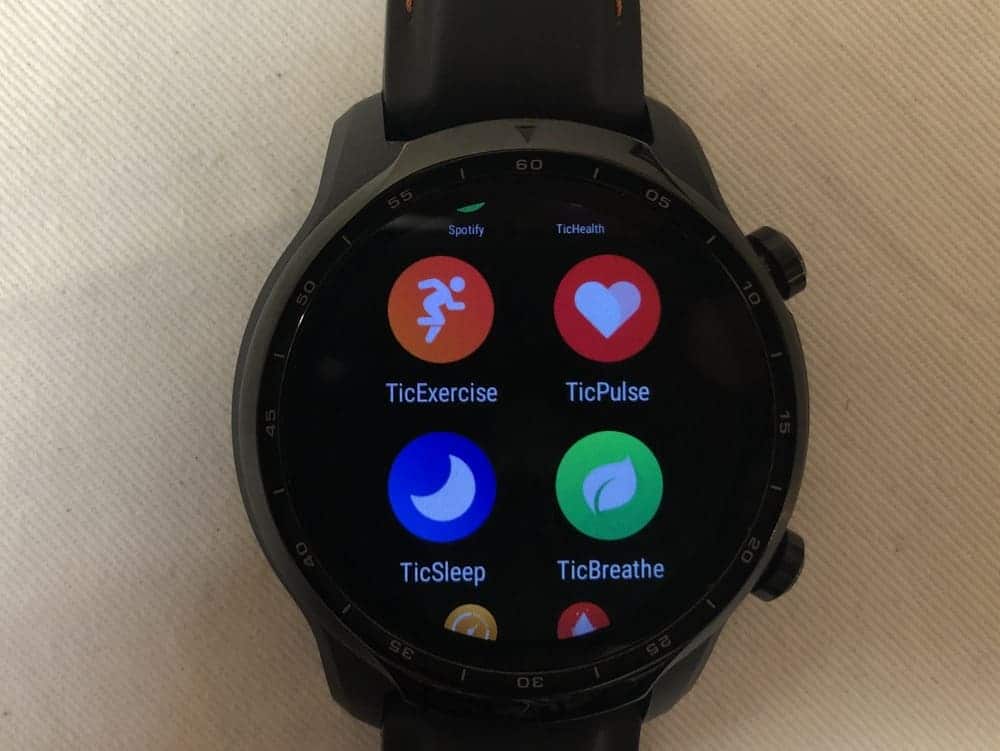
Ticwatch-specific Software
There are significant software improvements on the Ticwatch Pro 3 as compared to its predecessor.
On all Mobvoi watches, Mobvoi includes their own proprietary software. It’s prefixed with a “Tic”
The classic TicHealth, TicExercise and TicPulse are back. Then there are the new apps: TicSleep, TicZen, TicBreathe and TicOxygen.
When you first use your smartwatch, you must open these apps one by one in order to grant them permission. Only then can they start tracking the data that will eventually go into the Mobvoi smartphone app.
The Mobvoi smartphone app gathers all these data and sorts them out by day.
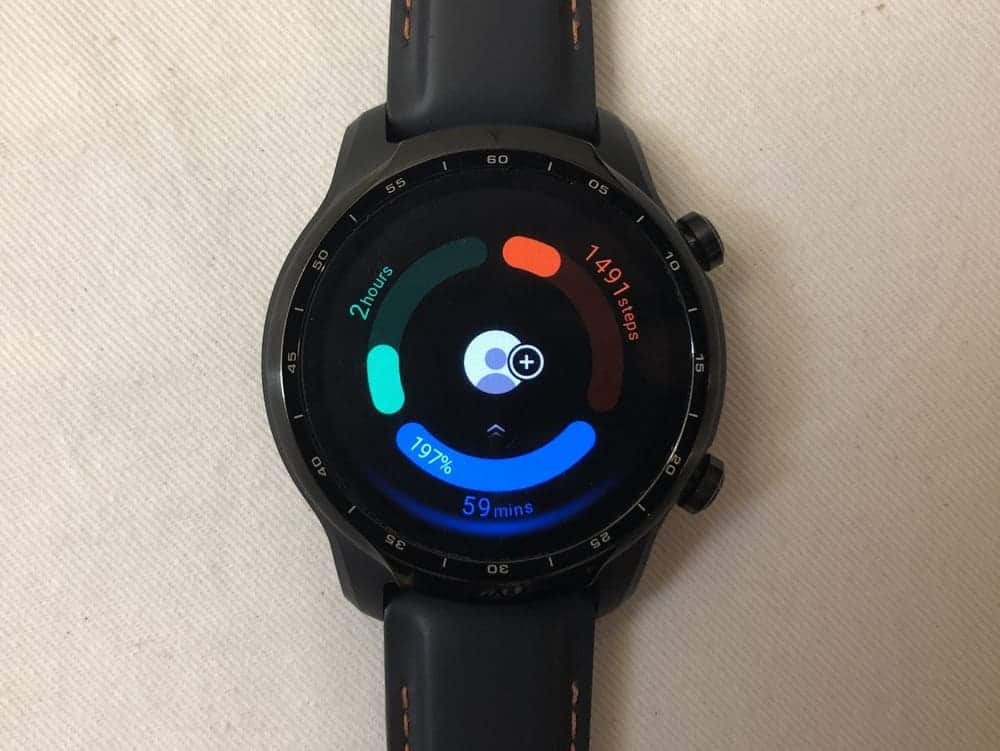
TicHealth
TicHealth functions in the same way as you would expect any smartwatch app that has a name of this nature.
It’s not as comprehensive as Samsung Health or Apple’s Health, but it functions more similarly to Google Fit Goals.
First off, TicHealth tracks your steps, exercise minutes and active hours. You set these goals and the Ticwatch Pro 3 will remind you and encourage you to achieve these goals.
For example, after clocking 145 minutes of exercise, TicHealth notified me that I have achieved my goal. Also, if I haven’t moved for an hour, it will notify me that I should do some steps.
You can also track the calories burned, distance travelled, your mood, and how much high-intensity exercise you’ve done.
High-intensity exercise time is set to 30 minutes per day by default and based on research from the Beijing Sports University Joint Laboratory of Human Science which says that doing at least 30 minutes per day (or at least 150 minutes per week) or high intensity workouts can improve cardio function, sleep quality, stress levels, thereby reducing the risk of arrhythmia, palpitations, insomnia and even sudden death.
High intensity activity is defined as activities that get your heart rate to 75 per cent or more of your maximum (measured as 220 minus your age).
For a 40 year old person, that means any exercise that hits 135 beats per minute or more is tracked as high intensity activity. That’s equivalent to running at speed or climbing hills on a bicycle.
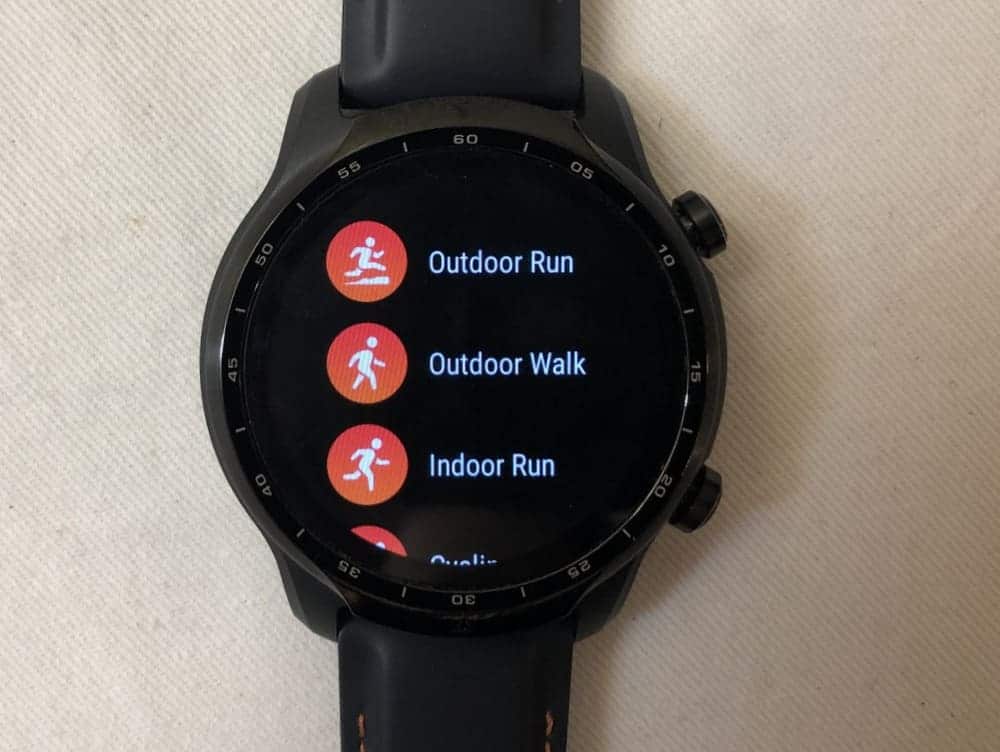
TicExercise
Mobvoi’s own counterpart to Google Fit Workout has been improved and the one thing it has over the standard Google Fit suite is that it can track swims.
Otherwise, I much prefer Google Fit because it’s much more comprehensive.
But let’s talk about TicExercise. The app gives you a 10 workout modes to pick from including runs, walks, cycling, gym exercises, hiking and a few others.
TicExercise tracks various data points including distance, duration, calories burned, average heart rate and average speed.
On the Mobvoi smartphone app, you can see a graph of your heart rate, speed and a mapping of your route.
TicExercise doesn’t really impress me because it’s competing with Fit Workout and Fit Workout is actually very good. Not only does it have way more workouts than TicExercise, it also looks better in my opinion.
For example, Fit Workout displays different information on different screens so that when you’re in the heat of a workout, you can tell what your heart rate is or how much calories you’ve burned.
It’s a bit harder with the TicExercise app as the default screen shows the time elapsed with the biggest font while information such as your heart rate or pace takes on a smaller font. So, it just takes a bit more time to figure it all out.
But the good thing about the TicExercise app is that you get the information on the power-saving LCD screen whereas with Google Fit, you do not. This means that if you wanted to use Google Fit as your main exercise tracker, you will need to press a button in order to see your stats.
What a bummer if you actually prefer Google Fit.
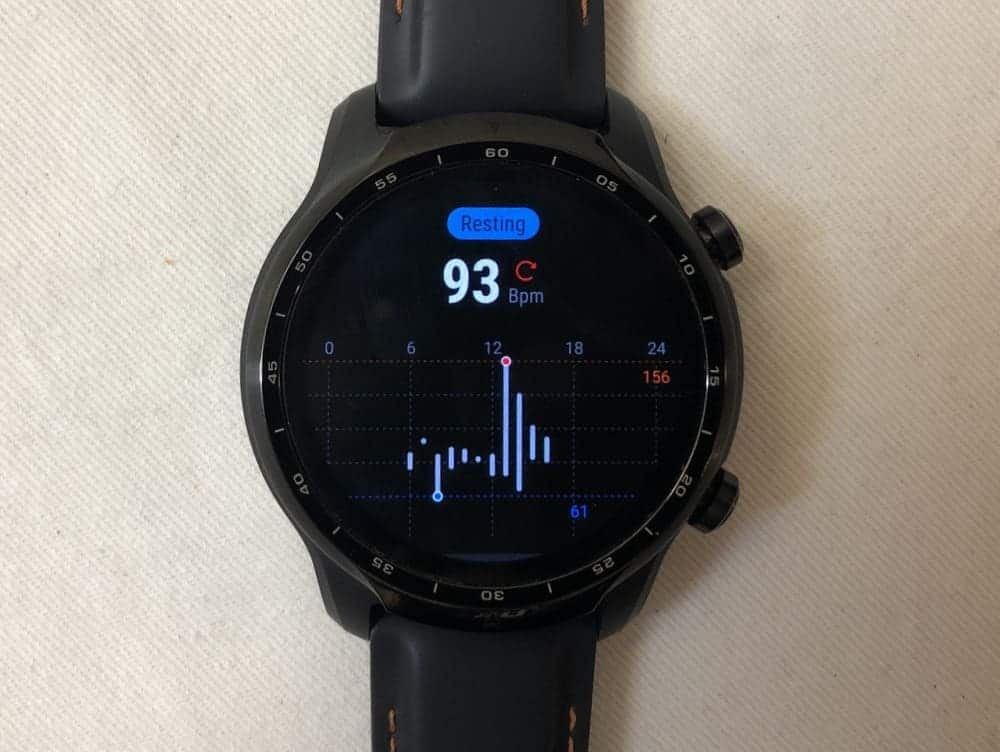
TicPulse
The TicPulse app is a heart rate tracker that analyzes your heart rate. It can tell you if there’s anything abnormal with your heart rate as it can tell your resting heart rate. It can also analyze your heart rate and split them into zones.
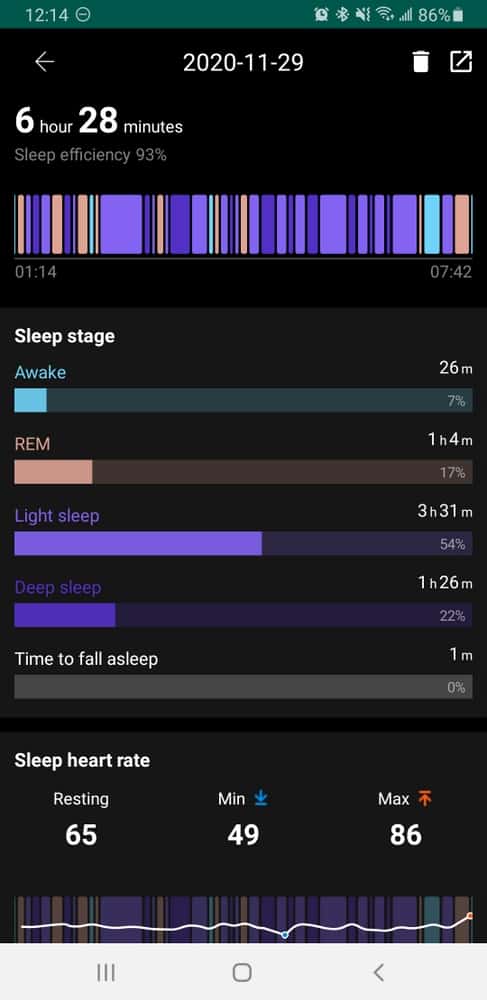
TicSleep
This is a major augmentation to Mobvoi’s suite of apps. A sleep tracking app has become quite a mainstay in all smartwatches these days and so Mobvoi would be really left behind if it didn’t add one in. I mean, even Fossil and Apple have sleep tracking on their smartwatches.
TicSleep tracks your sleep automatically and it seems quite reliable. When I go to sleep at night, it’ll track it more or less in the ballpark of where I think I went to sleep.
It’ll then use its sensors to categorize your sleep into different sleep stages in the awake, REM, light sleep and deep sleep categories.
It has one more data point which is “time to fall asleep” and somehow that’s a bit hit and miss. I know for a while, I had a really hard time falling asleep and so I don’t believe it when it says it only took me one minute to fall asleep.
On the Mobvoi app, you can also find out about how your heart rate fluctuated as you slept and your morning heart rate which is categorized into slow to fast, and then “alarm.” It tells you your morning pulse rate, frequency and fluctuation.
I am not sure what this section is used for. Unfortunately, this is a trend that many watch manufacturers are falling into — offering more and more health data but less and less direction as to what the data can be used for.
It also tells you your blood oxygen level during sleep.
One nice feature that I like is the smart alarm. TicSleep monitors when you’re at your lightest sleep stage and wakes you up around the time you’ve set your alarm. This helps you avoid being groggy from getting roused by an alarm when you’re in deep sleep.
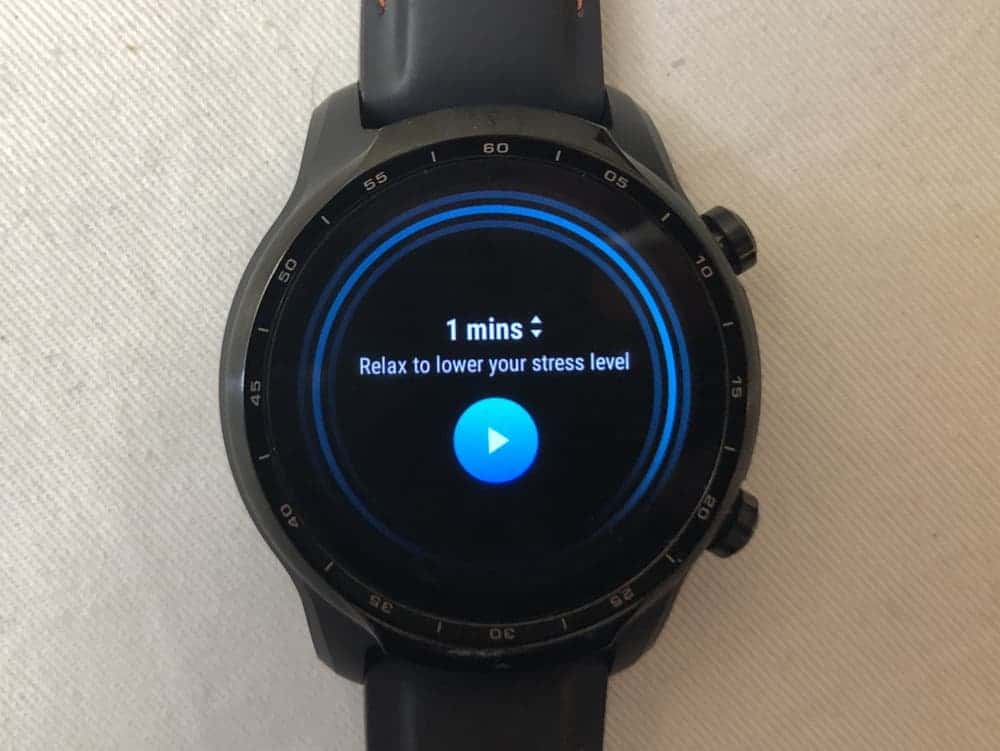
TicZen and TicBreathe
The first time I saw a stress measurement feature was on the Garmin Fenix 6, an elite sports smartwatch. It has now trickled down to general purpose smartwatches such as the Ticwatch Pro 3, which is great.
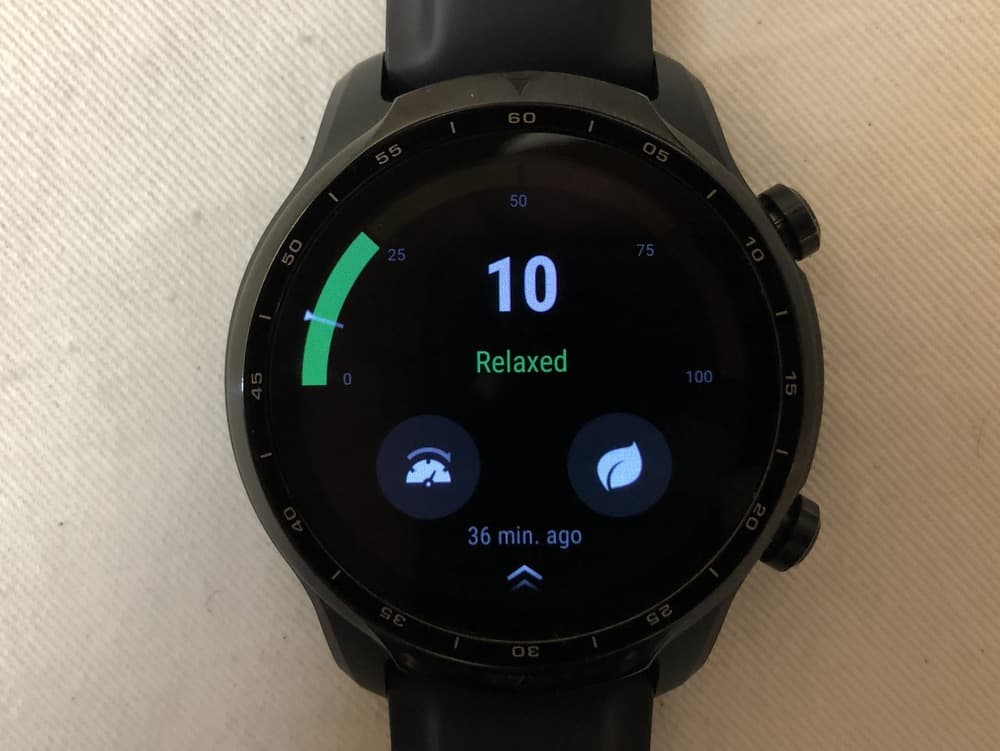
TicZen measures your stress by analyzing your heart rate variability and then puts your stress category into “relaxed,” or low, medium or high stress.
You can put it on 24 hour tracking and it will measure this figure every 30 minutes.
TicZen also pairs with TicBreath which helps you with an inhale-exhale rhythm. The Ticwatch Pro 3 vibrates every time you need to inhale and then stops vibrating on the exhale step.
TicOxygen
Smartwatch manufacturers are going all-in with the SpO2 metric these days. Garmin, Fitbit, Apple and now Mobvoi’s Ticwatch Pro 3 has it.
TicOxygen measures your blood oxygen saturation level which also explains the red LEDs on the heart rate sensor.
The app gives you a record of your SpO2 levels over the day and over the week.
One thing I never found out is what a user could do with the SpO2 data. Here’s what Mobvoi says in the Ticwatch Pro 3’s landing page: “Automatically measures blood oxygen saturation 24/7, offering insight into your health.”
And then, an asterix with a caveat: “*Not intended as a medical device or for use in the diagnosis of disease or other conditions, or in the cure, mitigation, treatment, or prevention of disease.”
You’ll find that this line of “don’t sue me, I am not a doctor” disclaimer to be present in not just Mobvoi’s products but also other products that track this vital sign.
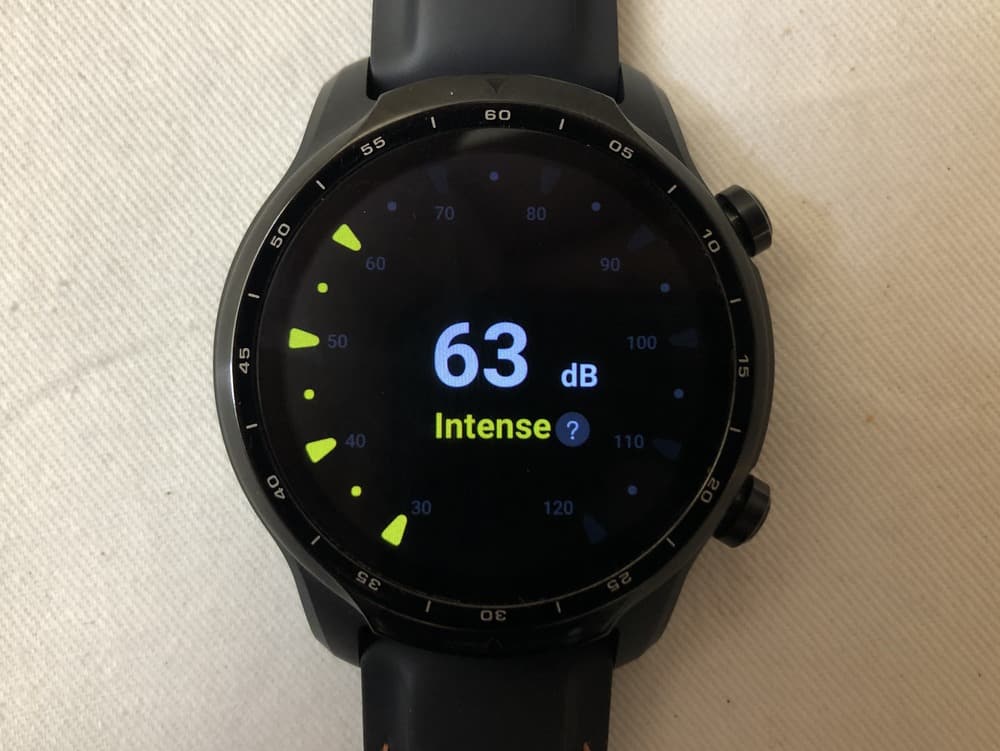
TicHearing
TicHearing helps you monitor your environment so you know when you are in a loud environment that can harm your hearing.
But unlike the Apple Watch’s counterpart, TicHearing isn’t as good. For one, it has a widget (AKA complication) that you can put on your watch face, but it does not refresh often. My room was about 47 decibels, but the widget kept saying 107 decibels.
The 107 decibels was probably from the time I shouted into the speaker so that I could see whether it would warn me that I was in a loud environment, like an Apple Watch would.
It didn’t.
So I am wondering if Mobvoi expects users to open the TicHearing app if they think they will be entering into a loud environment?
I am not sure what the best way to use this app to help me avoid hearing loss.

Productivity
The productivity benefits from the Ticwatch Pro 3 are really good. It really helps that the Ticwatch Pro 3 is built on Google’s Wear OS which makes it pair really well with Android phones.
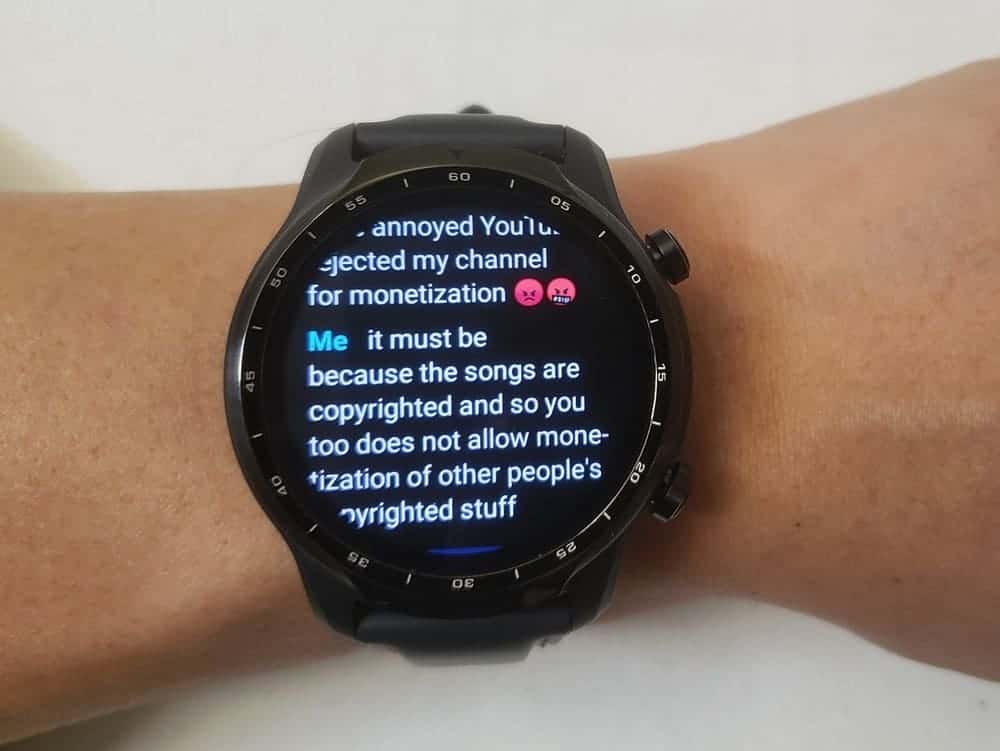
Texts and emails
Texting and emails on a Wear OS watch, when paired to an Android phone, is one of the better experiences out there.
On a side note, if you are pairing the Ticwatch Pro 3 to an Apple iPhone, do note that you can receive notifications but you can’t reply to them.
Texts from WhatsApp, Facebook Messenger and regular SMSes get forwarded from your phone into the Ticwatch Pro 3’s notifications. The same is true for emails.
You get to read a snippet from these notifications which is mostly enough for texts but generally not enough for emails.
There is no way to access your texts or email logs directly by default.
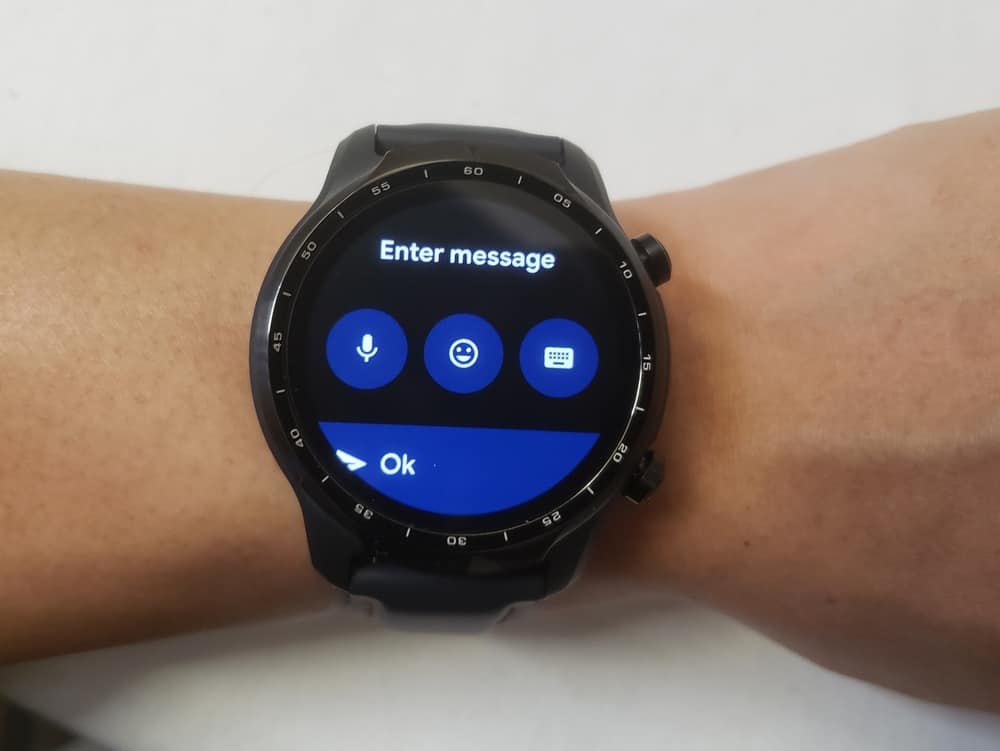
So when you want to reply, you get a few options. You can use the dynamically generated replies that Google creates based on what it reads off your received message or you can input a reply using your voice or through a keyboard.
The Wear OS is great in this regard because it has access to Google’s super powerful speech to text system.
Dictations are also noticeably quicker on the Ticwatch Pro 3. There’s no lag between when it says it’s ready to listen to you speak and when it is actually ready. On older, lesser watches, this is a real problem.
The quality of the transcription is as good as it gets and this is one of the biggest selling points of the Wear OS — that you get great transcriptions that you can rely on for your replies.
I never, ever use the keyboard or the handwriting feature (where you draw letters). I find those to be too tedious and would much rather just use my phone instead.
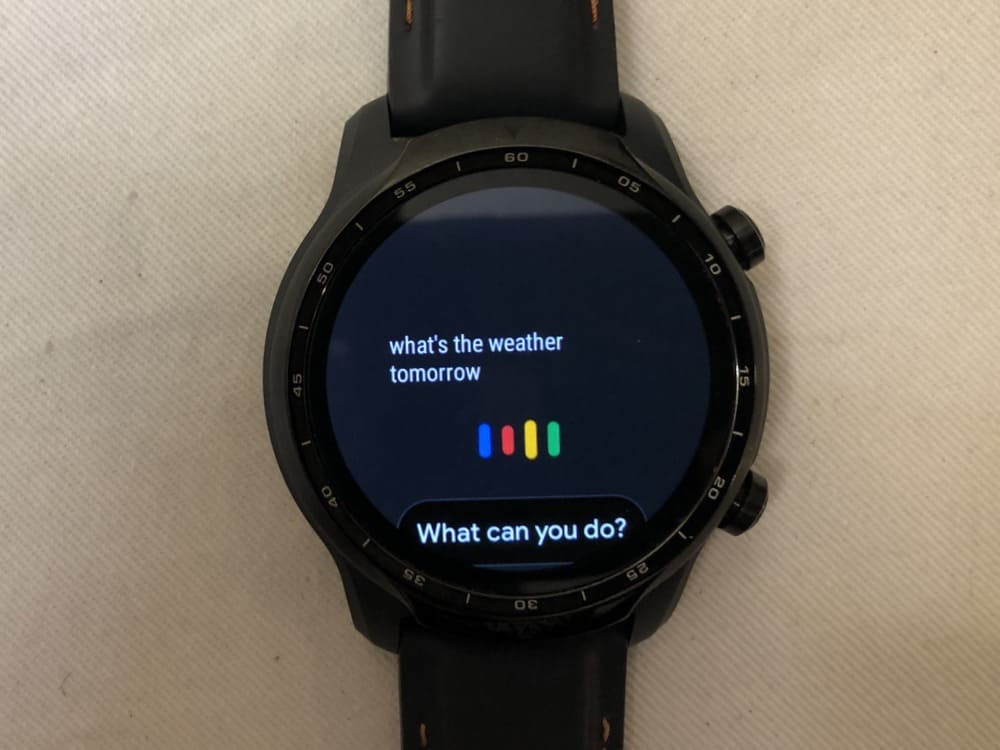
Google Assistant
With a great speech to text system comes a much better voice assistant. Google Assistant is the voice assistant that’s integrated into the Wear OS system.
Google Assistant can guess what you want and provide what you need, helped by a very accurate speech to text system.
The quality of the speech to text system was most noticeable when I tried Samsung Galaxy Watch smartwatches where their transcriptions were not as good. This led to Bixby not understanding what I wanted.
Furthermore, what really hit home the usefulness of Google Assistant was the fact that Google Assistant could deal with random questions such as navigation queries or trivia. Bixby couldn’t. Fitbit’s Alexa could, but would somehow think I’m always in Wilmington, Ohio, when I actually live in Canada.
So, Google Assistant is amazing. I am glad it’s on the Ticwatch Pro 3.

App store
The Google Play Store has some of the most interesting apps out there and I really love that you get access to Google apps such as Google Maps, Keep and Translate.
If you are a fan of these Google apps, then you are in luck. These apps do require that you have an active online connection, so don’t forget to bring your phone.
Otherwise, you can download various apps such as games, news apps, grocery list apps and music apps.
Verdict
The Ticwatch Pro 3 is a major advancement from every other watch made by Mobvoi and I really like it.
The best part about the Ticwatch Pro 3 is that it is very comprehensive and can keep up with the top tier watches from other manufacturers. Its features parallel closely the Fitbit Sense and Apple Watch Series 6 and outshines Fossil’s flagship Gen 5.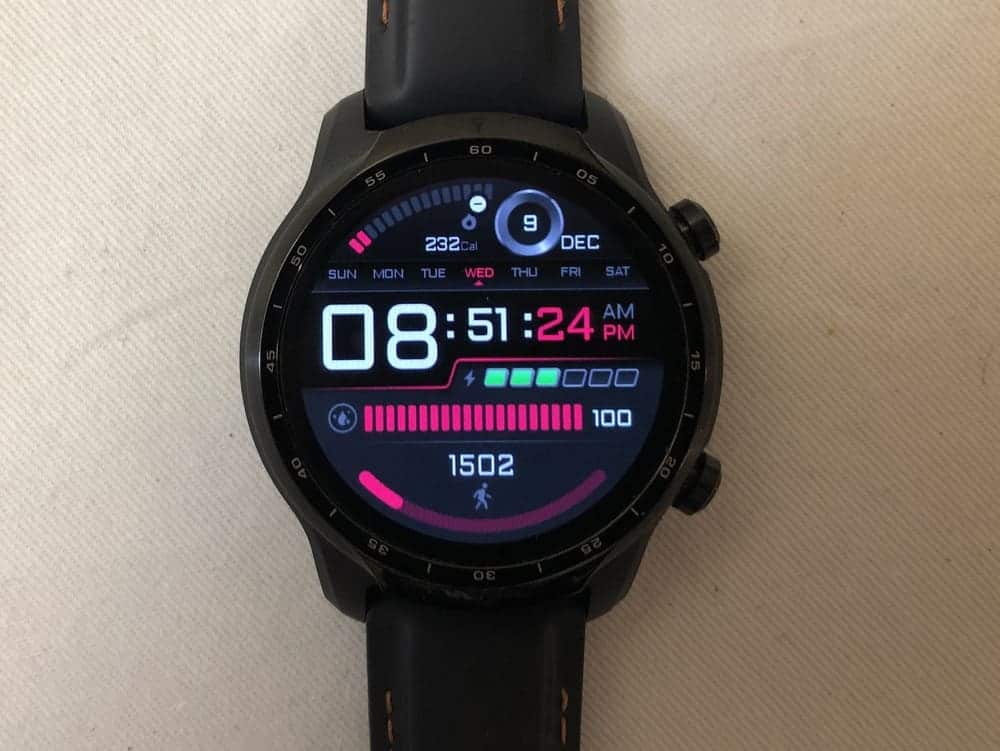
For a Wear OS smartwatch, its battery life is also excellent, especially considering this is a watch meant to be worn 24/7 and still can last two full days if not more.
The dual layer screen is an excellent innovation and I love how it has its own backlight. The original Ticwatch Pro did not and you could only see the time by activating the battery sapping LED screen.
I really love this smartwatch and it has honestly dethroned my previous favourite Wear OS smartwatch, the Fossil Gen 5 Carlyle. It takes the top spot because it has great battery life for a Wear OS smartwatch, a very innovative and improved dual layer screen and all the best parts about the Wear OS with a good performance package that negates all the sluggishness that’s possible with the Wear OS and a lesser system.
FAQs
Is Ticwatch Pro 3 compatible with iPhone?
Yes, the Ticwatch Pro 3 works fine with an iPhone.
Wear OS smartwatches are generally not able to take or make calls when paired to an iPhone. Wear OS smartwatches can only read received messages and emails via the notifications but not reply.
Will Ticwatch Pro 3 have LTE?
Cellular connectivity, also known as LTE connectivity, is happening, but not for everyone.
The Ticwatch Pro 3 actually has the Snapdragon Wear 4100 chipset which has integrated LTE compatibility, but only in December 2020 did Mobvoi release an LTE version in various European countries.
At the time of writing, there is no news as to what Mobvoi’s plans are for the North American market.
Where to buy Ticwatch Pro 3
You can buy the Ticwatch Pro 3 at Mobvoi’s website, on Amazon or at your local electronics retailer.
Ticwatch Pro 3 vs Apple Watch Series 6
The Ticwatch Pro 3 can’t beat the Apple Watch Series 6. No general purpose smartwatch can beat the Apple Watch Series 6.
Unless you don’t use an iPhone, then the Apple Watch loses most of its smart functionality because it won’t pair with an Android.
That said, in terms of functionality, the Apple Watch Series 6 beats the Ticwatch Pro 3 because it can take calls (on an iPhone) and also reply to messages (on an iPhone). Wear OS smartwatches generally can’t do this.
But the Ticwatch Pro does have a good number of vital signs that it tracks which parallels what the Apple Watch can offer: SpO2, noise monitoring, stress levels and also has the Mobvoi app which is the one-stop app for details about your health.
Plus, the Ticwatch Pro’s dual layer screen gives it better battery life than the Apple Watch Series 6, despite all the improvements to the Apple Watch’s battery life with its new hardware.
At the end of the day, the Apple Watch Series 6 is really the smartwatch to buy for iPhone users, but the Ticwatch Pro 3 is quite good.
Ticwatch Pro 3 vs Fitbit Sense
The Fitbit Sense is a really impressive smartwatch and I really liked it.
I liked how it has such a comprehensive suite of health monitoring features. Both the Ticwatch Pro 3 and Fitbit Sense have SpO2 monitoring, sleep quality tracking, workout recording and stress management.
The one thing that the Fitbit Sense has over the Ticwatch Pro is its EDA scan which allows you to gauge better how stressed you are by measuring your electrodermal activity.
The Fitbit is also a much more compact smartwatch than the Ticwatch Pro. I find it so much easier to wear 24/7 because it’s just so much more comfortable, particularly when sleeping. The Infinity Band is also really good and a little better than the strap that comes with the Ticwatch Pro 3.
Fitbit also promises that the Sense will be able to answer calls and will have Google Assistant instead of Alexa soon. That process has started in the United States but not here in Canada. With this update, though, the Fitbit Sense would become even more useful and I would find it difficult to recommend the Ticwatch Pro 3 unless you really want the Wear OS.
Ticwatch Pro 3 vs (original) Ticwatch Pro
Forget the original Ticwatch Pro.
The Ticwatch Pro has been sent deeper into obsoletion as a result of the Ticwatch Pro 3. Every feature that the Ticwatch Pro had, the Ticwatch Pro 3 has surpassed.
Not only does the Ticwatch Pro use a really old Snapdragon Wear 2100 processor, it also does not compare well with the Pro 3 in terms of battery life, health features and speed.
To add fuel to the fire, the Ticwatch Pro is larger and heavier.
The only upside is the price, but I assume if you want to buy one smartwatch for the long term, you would choose the Ticwatch Pro 3 for its superiority in all regards.
Ticwatch Pro 3 vs Fossil Gen 5 Carlyle
I used to think the Fossil Gen 5 Carlyle is the best Wear OS smartwatch out there.
It’s still very good. It’s quite fast and has some features that are not available in most Wear OS smartwatches. For example, the Fossil Gen 5 Carlyle can accept calls from iPhones. The Ticwatch Pro 3 cannot.
The Fossil Gen 5 smartwatches also come with various designs — the Carlyle comes with a unique band and clasp rather than the traditional strap and buckle. I like the band and clasp a lot.
But in terms of speed, the Ticwatch Pro 3 can’t be beaten. It’s just so fast and smooth and the Ticwatch Pro 3 has a much more advanced suite of health monitoring features including SpO2, noise monitoring and stress tracking.
Ticwatch Pro 3 vs Ticwatch C2/E2/S2
Forget all the entry level Ticwatches and get the Ticwatch Pro 3 unless you’re looking to save money.
The Ticwatch S2 is marketed as a watch for strenuous sports such as mountaineering. I wouldn’t take the S2 if I had the Pro 3 because the Pro 3’s battery life is much more substantial, particularly if you are going to expose it to the cold. This reason extends to the Ticwatch E2, which is very similar to the S2 except for a small difference in design and the S2 has a MIL-STD-810G durability rating.
The C2 is marketed as an urban smartwatch. It’s small and compact so its design is something that you might like. It also has a full day’s battery life so it’s better than the Fossil Sport Smartwatch. But the Ticwatch Pro 3 can do all of that, last longer and you can get things done faster because it has a processor that’s two generations newer. You can also make and answer calls on the Ticwatch Pro 3.
So, if you are willing to spend the money and are OK with the size of the Ticwatch Pro 3, then you should get the Ticwatch Pro 3 for its superior features, performance and longevity.
Ticwatch Pro 3 vs Suunto 7
The Suunto 7 is a really good Wear OS smartwatch that has the best workout tracking features.
My favourite feature of the Suunto 7 is the offline maps. I find this to be very useful when I am out exploring new trails because I no longer have to rely on my smartphone for navigation. It’s very convenient when it’s all on your wrist and does not require a data connection, which might be hard to find deep in the woods.
That said, the Ticwatch Pro 3 has a much better set of health monitoring tools that monitor noise levels, stress and sleep quality. The Suunto 7 does not have any of these features.
In exchange, you get a really good set of workout analysis tools on the Suunto 7 that you don’t get on the Ticwatch Pro 3. For example, the Suunto app can tell you about how much recovery time you should schedule as well as how your workouts are improving your fitness.
Ticwatch Pro 3 vs Samsung Galaxy Watch3
The Samsung Galaxy Watch3 is a really good looking premium smartwatch from Samsung. It comes with the rotating bezel that’s really useful.
Every time I use the Galaxy Watch3’s bezel, I am reminded of how the Ticwatch Pro 3 doesn’t even have a crown, making scrolling through menus and messages a lot more of a hassle.
I also prefer the design of the Samsung Galaxy Watch3’s Tizen OS. It just looks better. Wear OS has always felt much more utilitarian and less cohesive, but that’s bound to happen when there isn’t a monolith controlling every detail.
Samsung’s workout and health features are comparable to the Ticwatch Pro 3, but for some reason, they are still disabled here in Canada. For example, I know the Samsung Galaxy Watch3 can detect stress and SpO2, but these are not available here. These features are available on the Ticwatch Pro 3.
On the productivity front, Samsung can’t really compare with the Wear OS’s effectiveness in speech to text and voice assistant quality. Wear OS consistently gets better speech to text transcriptions and Google Assistant gives better results than Bixby.
Ticwatch Pro 3 vs Garmin Fenix 6
If you are looking at the Garmin Fenix 6, you’re probably looking for a high-end sport smartwatch.
The Garmin Fenix 6 is a real delight to use if you want offline maps, workout analyses and a battery life that lasts over a week. It can also do sleep tracking and SpO2 measurements.
Besides the cost of the Garmin Fenix 6, the biggest difference between the Ticwatch Pro 3 and the Garmin Fenix 6 is the productivity features the Ticwatch Pro 3 has.
The Ticwatch Pro 3 has a voice assistant and it can also reply to messages and emails using the speech to text system. The Garmin Fenix 6 does not have a voice assistant and replies to messages and emails are done through pre-composed replies that you can edit in the Garmin Connect app.
The Garmin Fenix 6 is also a huge smartwatch with its imposing weight and size. It’s not a very comfortable smartwatch to sleep with if you want to do sleep tracking.
Ticwatch Pro 3 vs Polar Grit X
Every time I wear a Polar smartwatch, I feel like I have sacrificed it all to get access to its workout and lifestyle features.
The Polar Grit X is a great watch if your main purpose of getting a smartwatch is to become a better athlete and live a healthier lifestyle.
You get a few features that are unique such as route navigation, FuelWise (a nutrition and water intake reminder), FitSpark (workout planner) and a running power meter, among many other features.
But you can’t reply to messages or emails on the Polar Grit X nor could you answer calls. No voice assistant either. The Polar Grit X is just a smartwatch that puts minimal focus on enhancing your productivity.
The Ticwatch Pro 3 might not have such an advanced set of workout and health features but its productivity features are excellent.
I think if you are picking between these two watches, you’re picking the extremes between a general purpose watch and a sports focused smartwatch. If you’re not ready to sacrifice that much for the Polar Grit X, there are other sport smartwatches around from Fitbit and Garmin that might find a better balance.
For most, the Ticwatch Pro 3 would be a better choice for daily use as it covers more ground.



